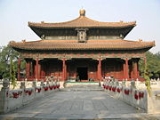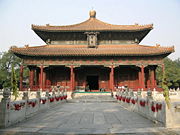
Guozijian
Encyclopedia


Sui Dynasty
The Sui Dynasty was a powerful, but short-lived Imperial Chinese dynasty. Preceded by the Southern and Northern Dynasties, it ended nearly four centuries of division between rival regimes. It was followed by the Tang Dynasty....
. It was the highest institute of learning in China
China
Chinese civilization may refer to:* China for more general discussion of the country.* Chinese culture* Greater China, the transnational community of ethnic Chinese.* History of China* Sinosphere, the area historically affected by Chinese culture...
's traditional educational system. In Vietnam, the Imperial Academy (Quốc Tử Giám) existed after the Lý dynasty.
History
Formerly it was called the TaixueTaixue
Taixue , or sometimes called the "Imperial Academy", "Imperial School" , "Imperial University" or "Imperial Central University", was the highest rank of educational establishment in Ancient China between the Han Dynasty and Sui Dynasty. It was replaced by the Guozijian...
, while Taixue for Gongsheng (tribute students) from the populace was still part of Guozijian, along with Guozixue for noble students. The central schools of taixue were established as far back as 3 CE, when a standard nationwide school system was established and funded during the reign of Emperor Ping of Han
Emperor Ping of Han
Emperor Ping was an emperor of the Chinese Han Dynasty from 1 BC to AD 5. After Emperor Ai died childless, the throne was passed to his cousin Emperor Ping—then a child of nine years old. Wang Mang was appointed regent by the Grand Empress Dowager Wang...
. When disbanded during the 1898 reform of the Qing Dynasty, the Guozijian was replaced by the Imperial Capital University, later known as Peking University
Peking University
Peking University , colloquially known in Chinese as Beida , is a major research university located in Beijing, China, and a member of the C9 League. It is the first established modern national university of China. It was founded as Imperial University of Peking in 1898 as a replacement of the...
.
Locations
Guozijian were located in the national capital of each dynasty, such as Chang'anChang'an
Chang'an is an ancient capital of more than ten dynasties in Chinese history, today known as Xi'an. Chang'an literally means "Perpetual Peace" in Classical Chinese. During the short-lived Xin Dynasty, the city was renamed "Constant Peace" ; yet after its fall in AD 23, the old name was restored...
, Luoyang
Luoyang
Luoyang is a prefecture-level city in western Henan province of Central China. It borders the provincial capital of Zhengzhou to the east, Pingdingshan to the southeast, Nanyang to the south, Sanmenxia to the west, Jiyuan to the north, and Jiaozuo to the northeast.Situated on the central plain of...
and Kaifeng
Kaifeng
Kaifeng , known previously by several names , is a prefecture-level city in east-central Henan province, Central China. Nearly 5 million people live in the metropolitan area...
. In Ming
Ming Dynasty
The Ming Dynasty, also Empire of the Great Ming, was the ruling dynasty of China from 1368 to 1644, following the collapse of the Mongol-led Yuan Dynasty. The Ming, "one of the greatest eras of orderly government and social stability in human history", was the last dynasty in China ruled by ethnic...
there were two capitals; thus there were two Guozijian, one in Nanjing
Nanjing
' is the capital of Jiangsu province in China and has a prominent place in Chinese history and culture, having been the capital of China on several occasions...
and one in Beijing
Beijing
Beijing , also known as Peking , is the capital of the People's Republic of China and one of the most populous cities in the world, with a population of 19,612,368 as of 2010. The city is the country's political, cultural, and educational center, and home to the headquarters for most of China's...
. In Qing there were also two Guozijian, one in Changsha and one in Beijing
Beijing
Beijing , also known as Peking , is the capital of the People's Republic of China and one of the most populous cities in the world, with a population of 19,612,368 as of 2010. The city is the country's political, cultural, and educational center, and home to the headquarters for most of China's...
. The Guozijian
Guozijian (Beijing)
The Beijing Guozijian , located at the Guozijian Street or Chengxian Street in Beijing, China, was the imperial college during the Yuan, Ming and Qing dynasties and it was the last Guozijian of China and is an important national cultural heritage...
, located in the Guozijian Street
Guozijian Street
Guozijian Street , formerly known as Chengxian Street , is a street in Dongcheng District, Beijing. It is listed as an important historical site....
(or Chengxian street) in the Dongcheng District, Beijing
Dongcheng District, Beijing
Dongcheng District is an urban district in Beijing covering the eastern half of Beijing's urban core. It is 24.7 square kilometres in area and has a population of 535,558 . Dongcheng District covers several important parts of Beijing...
, the imperial college during the Yuan, Ming and Qing dynasties (although most of its buildings were built during the Ming Dynasty) was the last Guozijian in China and is an important national cultural asset.
The Quốc Tử Giám was located in the Temple of Literature, Hanoi and later moved as the Imperial Academy, Huế.
Reference sources
- Yuan, Zheng. "Local Government Schools in Sung China: A Reassessment," History of Education Quarterly (Volume 34, Number 2; Summer 1994): 193–213.

